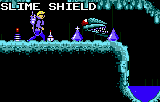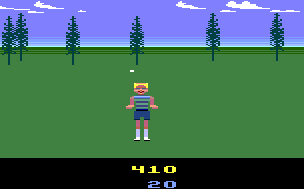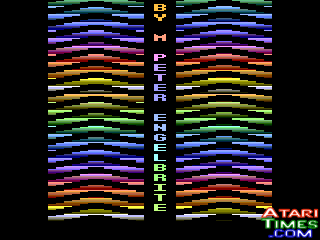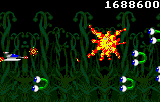 |
 |
The Games of Peter Engelbrite |
 Peter Engelbrite was a programming force at Epyx. He wrote several games for
the 2600 including Summer Games, Winter Games, and California Games. He
is also responsible for writing one of the most popular Lynx games, Slime World!
For the 2001 Year End Issue, Peter was gracious enough to write this interview.
Peter Engelbrite was a programming force at Epyx. He wrote several games for
the 2600 including Summer Games, Winter Games, and California Games. He
is also responsible for writing one of the most popular Lynx games, Slime World!
For the 2001 Year End Issue, Peter was gracious enough to write this interview.I guess the first computer game I ever wrote was a Lunar Lander game on an HP-25 programmable pocket calculator.It had no graphics, so you had to look at position and altitude values to determine your location.Back then (around 1973-74) it was exciting to be able to program anything.It was kind of like having your own rocket pack, or genetic engineering lab.I worked at the "Retail Computer Store" in Seattle who sold systems like the Altair, Imsai, SWTP, and the SOL Terminal Computer.Back then, we poked the bits into strips of paper and the leftover bits would make a mess on the floor.I saw the first floppy drives (if you picked them up by the corners they would go out of alignment).But we were thankful for it, by cracky!
|
Peter Engelbrite's list of games!
* unpublished ** unfinished |
How did you find your way into Epyx? Did you ever work for Atari directly?
I never worked for Atari. I worked for Epyx, the people who designed the Lynx, which was then sold to Atari. We did write games for Atari. When Craig Nelson at Epyx interviewed me, he game me a test: "what's the fastest was to fill 256 bytes of memory with 0's?"I guess I passed the test, because I was hired.
Is there any one Atari system that stands out as being your favorite?
In a lot of ways, I think my favorite was the 2600. I was always impressed that you could actually create a game with almost nothing.
What was the easiest and hardest system to program for?
In a way, no system is harder or easier to program, because when you have a more powerful system, people expect more of you. The 2600 was the hardest thing to program but if you got anything to work, everyone was amazed. Nowadays, if the smallest thing is off, you can get nasty reviews.
Of the games you worked on, which one are you most proud of, and why?
 Of the Atari games, I would say definitely
Slime World.It was a fun game with a unique concept.It also won an award. It was sort of the "Massively Multiplayer Online Role Playing Game" of the day: 8 players were pretty massive back then.Come to think of it, it's pretty massive for a game system today. People have commented that the music in
Slime World is weak.What people don't know is that the music is being composed on the fly by the program.I didn't have room in the cart for the company music engine and data, so I wrote a system that used presets to compose based on a system of harmony, permutations, and rhythm. Does everyone know about the "extra" rooms at the end of the arcade level?
Of the Atari games, I would say definitely
Slime World.It was a fun game with a unique concept.It also won an award. It was sort of the "Massively Multiplayer Online Role Playing Game" of the day: 8 players were pretty massive back then.Come to think of it, it's pretty massive for a game system today. People have commented that the music in
Slime World is weak.What people don't know is that the music is being composed on the fly by the program.I didn't have room in the cart for the company music engine and data, so I wrote a system that used presets to compose based on a system of harmony, permutations, and rhythm. Does everyone know about the "extra" rooms at the end of the arcade level?
Are there any unreleased games you wish actually made it?
Well, all of them. However, in Barbarian Bodyguard, I was working with a new game concept: an asymmetrical two-player game.The game was about a princess who was being escorted by a barbarian bodyguard. He had brute strength abilities; she had magical ones. In the game, they would come upon two-sided power-ups. The type of power-up it was depended on who took it. It also had a hierarchical animation system and a 3D look and feel.
Are there any screenshots of Barbarian Bodyguard?
Barbarian Bodyguard was terminated about 1/3 of the way through development, along with all of the other Lynx titles. No screen shots were ever taken, and the source code is probably lost by now. The barbarian was a fairly typical Conan type with a sword, the princess was slender rather than buxom. There were Greek columns, and a pig warrior (sort of like the pig guards in Star Wars).
Have you been involved with the Supercharger (or programmed games for the 2600?) What was your role with the Supercharger?

 |
|
California Games displays a bunch of colors on the 2600! Written in just 6 weeks! (The same amount of time it took E.T. to be written!) |
I came in after the Supercharger days.I always thought it was a cool concept, though.I worked on three 2600 games
(Summer Games, Winter Games, California
Games) that were quite successful.There was a time after the "glory days" of the 2600 when the cost of the system had dropped to about $50 and there was a real demand for games.
Tell us what it was like at Atari during the early days of the Lynx. How
was the Gameboy perceived and what did Atari think of their chances
against it?
I remember an advertisement for the Gameboy that had a color illustration in the display window.We thought that was just a little pathetic.I think that in the long run, the Lynx was a great system, but missed the market because it was too large, too expensive and went through batteries too quickly.These are things that Atari could have fixed if they had continued to develop it.Even so, I'd rather play a Lynx game than a Gameboy game any day.
Give us a little insight on Atari's management job. Was their demise a result of bad management, or something more obvious (like the lack of advertisement)?
I think it was neither. I think Atari's problem was an inability to treat others right. Eventually their business partners refused to work with them.This included developers, retailers, and distributors.Epyx was creating games for the Atari to publish, but Atari refused to pay the royalties they owed, so Epyx eventually cancelled all Lynx projects (I was working on Barbarian Bodyguard at the time). Epyx had developed the Lynx for themselves, but then didn't have the cash to bring it to market. They shopped it around to all of the other companies but no one was interested.Atari was the last on their list.At one point in the negotiations with Atari, they were talking about taking over Epyx, but the entire development staff said that they would walk out in the case of an Atari takeover.The takeover never happened. Atari's overall attitude is a good object lesson in win/win business management.If you have the attitude that others must lose in order for you to win (win/lose), you may win the battle but you will lose the war. It's what I call "stupid greed". It's killing the goose that laid the golden egg.
What were the Tramiels like?
Keep in mind that I never actually spoke with the Tramiels, so my opinion is based on my understanding of how they dealt with Epyx and other companies. They got a reputation for stabbing you in the back at the earliest possible opportunity. I do know that they were paranoid about security at their plant, requiring authorization from one of the Tramiels personally for anything to be taken from the facility. I understand that people had to smuggle things in and out just to get their job done.
Do they deserve all the demonization that Atari fans have given them over the years?
Yes.
What advice would you give budding game programmers today?
 I think I mostly miss the people at
Epyx. I think the most exciting moment was when
Gates of Zendocon (Marketing came up with that name) first ran.
Zendocon was started for the Lynx before there was any functional hardware, so I created a crude Lynx emulator on the Apple II. It set up the Lynx graphics data structures, but then displayed them on an Emulator screen as ASCII text.The bouncing eyeballs were "*", and the laser beams were "-----". Eventually, they got a version of the Lynx hardware that could display graphics (slowly), and I saw
Zendocon actually running.
Other Recollections
I think I mostly miss the people at
Epyx. I think the most exciting moment was when
Gates of Zendocon (Marketing came up with that name) first ran.
Zendocon was started for the Lynx before there was any functional hardware, so I created a crude Lynx emulator on the Apple II. It set up the Lynx graphics data structures, but then displayed them on an Emulator screen as ASCII text.The bouncing eyeballs were "*", and the laser beams were "-----". Eventually, they got a version of the Lynx hardware that could display graphics (slowly), and I saw
Zendocon actually running.
Other Recollections
What are you doing these days?
I have my own little business (Just me and my wife, Eve): Inspired Idea (www.InspiredIdea.com). I am specializing in Bible computer games, but am also retailing some home school software.I just taught myself 3D programming in DirectX 8.I am finishing up my latest game:Teaches Bible Literacy in 12 Categories:
| Name: | |
| Subject: | |
| Comment: | |
| Check: | What is the greatest video game company of all time? (Hint: Atari.) |